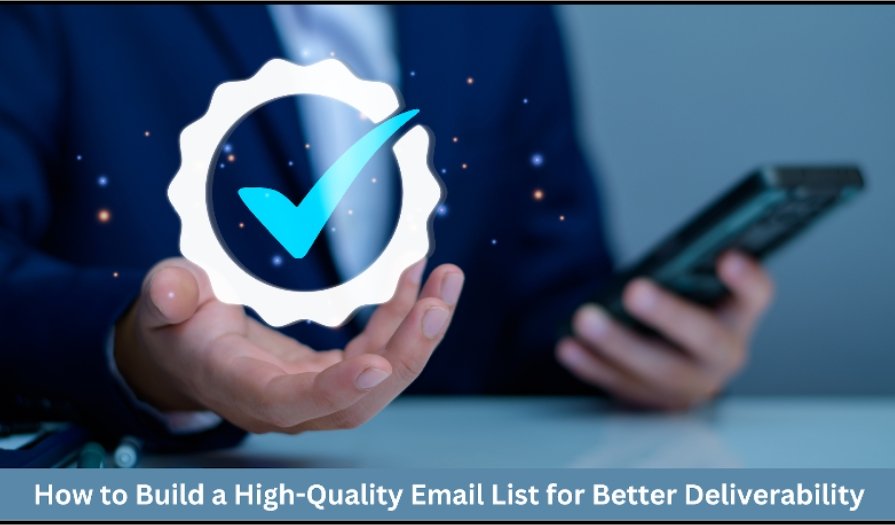Business
How to Build a High-Quality Email List for Better Deliverability

Email marketing remains a powerful tool for businesses, but its effectiveness depends on email deliverability, the ability to land in recipients’ inboxes rather than spam folders. With the average email deliverability rate in 2024 standing at 83%, businesses need to take proactive steps to build and maintain a high-quality email list that ensures better inbox placement, engagement, and conversions.
This guide dives straight into proven strategies for building an effective email list, keeping it clean, compliant, and highly deliverable while avoiding common pitfalls that hurt engagement.
Why a High-Quality Email List Matters
A poorly managed email list can lead to low engagement rates, high bounce rates, spam complaints, and deliverability issues, all of which damage your sender reputation. Understanding how to improve email deliverability is essential for maintaining a strong sender reputation and ensuring your emails reach the inbox.
Higher Engagement
If you concentrate on gathering email addresses of actually interested subscribers, your emails will receive more openings, reads, and actions. Your engagement rates, such as open rates, click-through rates (CTR), and conversions, improve since your recipients desire to hear from you.
Improved Deliverability
Email Service Providers (ESPs) such as Gmail, Outlook, and Yahoo give precedence to emails sent from senders who have high engagement and clean lists. If your emails consistently bounce, go unread, or become spam, your domain reputation plummets, and your emails will be blocked or sent to spam.
Clean your list regularly by deleting inactive subscribers, invalid emails, and spam traps to keep a healthy sender reputation.
Regulatory Compliance
Privacy regulations such as GDPR (General Data Protection Regulation), CAN-SPAM (U.S.), and CCPA (California Consumer Privacy Act) enforce strict guidelines on email marketing. Emailing individuals without consent, neglecting to give opt-out choices, or acquiring information illegally can lead to legal penalties and reputational harm.
Why Compliance Is Important
- GDPR demands express permission before the mailing of promotional emails to EU consumers.
- CAN-SPAM demands a prominent unsubscribe link in all mailings.
- CCPA provides consumers with the right to request the erasure of their data from their email lists.
Stronger ROI
Email marketing is one of the highest return-on-investment digital marketing channels, returning an average of $42 for every $1 invested. But this can only happen if your email list is comprised of active, high-intent recipients.
- High-Quality List = More Opens & Clicks → More Conversions → Higher Revenue
- Low-Quality List = More Bounces & Spam Reports → Poor Deliverability → Wasted Budget
If your email list is comprised of unverified leads or uninterested subscribers, you spend time and money sending campaigns that never get opened, cutting into your ROI.
The Foundation: Building an Opt-In Email List the Right Way
A permission-based email list is the key to long-term email marketing success. Rather than skimp on building the list with shortcuts such as buying email lists, which may result in spam issues, low engagement, and poor deliverability, marketers must concentrate on organic list-building strategies that draw in truly interested subscribers.
Use Double Opt-In for Verified Subscribers
One of the optimal methods to have a clean email list and avoid spurious signups is to have a double opt-in process in place.
What is Double Opt-In?
- Upon signing up, the user is sent an opt-in confirmation email and has to click on a link to confirm the subscription.
- Only confirmed users are placed on your email list, avoiding spam bots and erroneous emails.
Customize your confirmation email with engaging content (e.g., “You’re Almost There! Click to Confirm & Get Your Free Guide”).
Lead Magnets That Attract Quality Subscribers
A lead magnet is an incentive offered in exchange for an email address. The key to success is offering high-value content that aligns with your target audience’s interests.
Best Lead Magnet Ideas
- E-books & Whitepapers: Educational resources on industry trends.
- Exclusive Discounts & Coupons: A limited-time 15% discount for new subscribers.
- Webinars & Free Courses: Engage users while collecting high-intent emails.
- Free Templates & Checklists: Actionable resources that solve a problem quickly.
Optimize Signup Forms & Pop-Ups
Your signup forms should be clear, user-friendly, and optimized for conversions. If they’re too long or intrusive, users will bounce instead of subscribing.
Best Practices for Signup Forms
- Keep It Simple: Ask only for essential information (name, email, preferences).
- Use Exit-Intent Pop-Ups: Display a signup pop-up when a user is about to leave your site.
- Ensure Mobile-Friendliness: 70% of email signups happen on mobile devices.
What to Avoid:
- Too Many Fields: Asking for too much information leads to drop-offs.
- Aggressive Pop-Ups: Annoying users with pop-ups before they explore your site.
- Poor CTA Buttons: Weak phrases like “Submit” instead of “Get My Free Guide”.
A/B tests different form designs and CTAs to determine what drives the highest conversion rates.
Email List Hygiene: Maintaining Your List Clean and Active
A clean email list is the secret to high deliverability, improved engagement, and reduced spam complaints. If your list contains inactive subscribers, invalid addresses, or unengaged users, your email campaigns will be plagued by low open rates, high bounce rates, and possible blacklist threats.
By cleaning and optimizing your email list regularly, you can optimize performance and uphold a healthy sender reputation. Here’s how:
Regularly Clear Inactive & Invalid Contacts
- Remove hard bounces (inactive or deactivated emails) to avoid sender reputation harm.
- Unsubscribe inactive users who haven’t opened for 6+ months to keep your list healthy.4
- Employ email verification software to find and remove fake or inactive emails before sending out campaigns.
Re-Engagement Campaigns: Offer Subscribers a Second Chance
- Send focused “We Miss You” emails with discount or premium content to win back activity.
- Let subscribers control frequency through a preference center to decrease unsubscribes.
- Remove non-engaging users if they fail to act following re-engagement activity.
Freshen up your email list every 3 months to have great deliverability and inbox placement. A healthy list equals better open and conversion rates.
Deliverability Best Practices: How to Avoid Spam
Even with a quality email list, deliverability problems can happen. Employ these tested strategies to guarantee inbox delivery:
Authenticate Your Emails (SPF, DKIM, DMARC)
- SPF (Sender Policy Framework): Verifies emails originate from authorized servers.
- DKIM (DomainKeys Identified Mail): Prevents email tampering.
- DMARC (Domain-based Message Authentication): Protects against phishing attacks.
Avoid Spam Triggers in Subject Lines
- Steer clear of words such as “free,” “guarantee,” and “urgent,” and overuse of punctuation (!!!).
- Personalize subject lines with first names to boost open rates.
Warm-Up New Domains Before Sending Bulk Emails
- Gradually increase email volume to build a good sender reputation.
- Use email deliverability monitoring tools to track inbox placement.
Maximizing Engagement: Writing Emails People Want to Open
To enhance email marketing deliverability, emphasize engagement-led email content.
Personalization & Segmentation: The Key to Higher Open Rates
- Segment by purchase behavior, location, and preferences.
- Use dynamic content (e.g., product recommendations based on past behavior).
The Science of Subject Lines & Preview Text
- Keep subject lines under 50 characters.
- Use curiosity-driven wording: “You won’t believe this [first name]”.
Finding the Best Send Time
- Tuesday-Thursday mornings see higher open rates.
- Use A/B testing to identify the best timing for your audience.
Advanced Strategies: Leveraging Automation & AI for List Growth
Email automation drives engagement and retention.
Behavioral Triggers That Convert
- Welcome Sequences: Welcome new subscribers with personalized content.
- Abandoned Cart Emails: Reclaim abandoned sales with reminders.
- Loyalty Programs: Reward repeat customers with exclusive deals.
AI-Driven Email Optimization
- AI solutions predict the best send times and tailor subject lines.
- Automated A/B testing improves email performance over time.
Monitoring & Measuring Success: Key Metrics to Track
Regular performance tracking ensures email marketing success.
Essential Email Metrics
| Metric | What It Measures | Benchmark |
| Open Rate | % of recipients who open your emails | 20-25% |
| Click-Through Rate | % of users clicking on links in emails | 2-5% |
| Bounce Rate | % of emails not delivered | <2% |
| Unsubscribe Rate | % of users opting out | <0.5% |
Conclusion
Building a high-quality email list isn’t about volume—it’s about engagement, deliverability, and compliance. By following these best practices, you can increase open rates, avoid spam filters, and maximize conversions.
Need to check email deliverability? Start with an email verification tool and segment your audience for better results.
FAQs
- How much is a 1000 email list worth?
As you can see, pricing an email list isn’t an exact science. It might cost between $100 and $600 CPM (cost per mile, the price for 1000 email addresses) to purchase an email marketing list. The quality of the emails sent out and the characteristics of the list’s subscribers define the worth of an email list.
- What’s the best way to grow my email list without sacrificing quality?
Use double opt-in, lead magnets, and behavioral-based email automation instead of buying lists, which harms deliverability.
- What hurts email deliverability?
In short, elements such as sending without custom authentication, using single opt-in, sending from a free domain email address, using spam-flossing email subject lines, making it difficult to unsubscribe, using shorter URLs, and sending emails with too many images badly impact your email deliverability.
-

 Celebrity1 year ago
Celebrity1 year agoWho Is Jennifer Rauchet?: All You Need To Know About Pete Hegseth’s Wife
-

 Celebrity1 year ago
Celebrity1 year agoWho Is Mindy Jennings?: All You Need To Know About Ken Jennings Wife
-

 Celebrity1 year ago
Celebrity1 year agoWho Is Enrica Cenzatti?: The Untold Story of Andrea Bocelli’s Ex-Wife
-

 Celebrity1 year ago
Celebrity1 year agoWho Is Klarissa Munz: The Untold Story of Freddie Highmore’s Wife
















